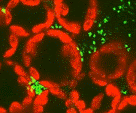Plant Pathology, Department of

Department of Plant Pathology: Faculty Publications
Document Type
Article
Date of this Version
7-1990
Citation
Int J Syst Bacteriol July 1990 40:312-316; doi:10.1099/00207713-40-3-312
Abstract
Improvement of the taxonomy of the genus Xanthomonas and especially of Xanthomonas campestris, which is subdivided into more than 125 pathovars, is discussed. Recent contributions to the taxonomy of Xanthomonas are reviewed, and on the basis of these data and unpublished data from several laboratories, the usefulness of different phenotypic, chemotaxonomic, and genotypic techniques is discussed. The heterogeneity of several X. campestris pathovars has been demonstrated by sodium dodecyl sulfate electrophoresis of whole-cell proteins and fatty acid fingerprinting. The host selectivity of the pathovars is not correlated with their relationships as revealed by DNA-DNA hybridization experiments. In order to reveal the phylogenetic relationships among X. campestris pathovars and their relationships to other Xanthomonas species, it will be necessary to perform extensive DNA-DNA homology studies as an essential part of a polyphasic approach. At present, six DNA homology groups within X. campestris have been delineated. A systematic approach to improve the taxonomy of the genus Xanthomonas is proposed.


Comments
Copyright 1990, International Union of Microbiological Societies